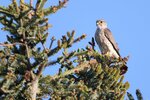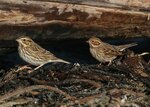



Our most overlooked local falcon species is the Merlin. One of its sub-species (see below) is a fairly regular sight in the winter; the Olympia Christmas Bird Count typically finds four or more Merlins in our area. As typical of falcons, Merlins have long, pointed wings and are fast-flying and agile avian predators.
They hunt a wide variety of small sparrow-sized birds, but they also are known to take shorebirds and doves on occasion. They typically perch in the open, but because of their upright posture and stillness, they are often overlooked, both by their prey species and by bird watchers.
Merlins are found around the globe but only in the Northern Hemisphere. In Europe they have been used for centuries in falconry and are preferred by some because of their fierce hunting nature but relatively light weight.
The common name Merlin comes from Old French, esmerillon, coming into English post-1066 and transposed as merlion. Its derivation is unrelated to the famous magician of King Arthur’s days.
Merlins are a widespread breeding bird in North America and are not in the least endangered. They often use abandoned nests of other raptors, and sometimes nest in crevices in rock outcrops. They typically have four eggs and, if prey is sufficient, most young survive to fledge. Northernmost breeders migrate south, but many of the Merlins breeding in Washington remain all year.
Merlins are small falcons (between robin and crow-sized), much larger than Kestrels; females are about 40% larger than males. We have a regional subspecies, the Black Merlin, breeding in Western Washington, primarily along the coast. It is a very dark brown, with only faint and not obvious face markings compared with other Merlin subspecies (and all other falcons).
Black Merlin
A second Merlin subspecies seen in Washington is the Taiga Merlin. It is still dark, but much paler than the Black Merlin. Its back and head are medium gray, and it has noticeable face markings - a moustache and a white eyebrow stripe. Birders are thinking about the Taiga subspecies, particularly in the autumn, since that’s when we often see them birds as they migrate through, again especially in coastal areas.
Taiga Merlin
Last week Liam and a few others were birding on the Makah Indian Reservation, specifically at Hobuck Beach on the Pacific Ocean. Liam identified a very rare bird from Eurasia, a Little Bunting. It was only the 2nd sighting in Washington and the 9th for the Lower 48 States. Very rare indeed!
Little BuntingSavannah Sparrow & Little Bunting
It was hanging out with a Savannah Sparrow in small trees and along the high tide line of the beach. Because of what happened next, it was fortunate Liam and others got some great photos to document this rarity. Here’s the rest of the story, in Liam’s own words:
About five minutes later, the Bunting and Savannah Sparrow suddenly took to the air, flying fast north up the beach gaining altitude the whole way. We watched them as they flew up and over the river mouth, thinking they were good as gone. Just then, a Taiga Merlin appeared out of nowhere pursuing the unlikely passerine pair. The Savannah flew down and into the grass, but the Bunting did not. It curved its course, heading east up the river. The Merlin made several dives at it, each one being a near miss. Just as the Bunting started to lose altitude and headed towards the grass, the Merlin succeeded. We watched it grab the bunting midair, and fly back to its spruce perch, bunting in its talons.
What irony. Here’s an extremely rare bird far out of its normal range on Washington’s extreme northwest coast. Liam and a few others come along, Liam identifies it, and they take a few photos. And then, it’s gone forever, thanks to a hungry Merlin.
The Little Bunting, incidentally, was Liam’s 372nd bird species for the year; he’s closing in on the state's big year record of identifying 375 species.
George Walter is environmental program manager at the Nisqually Indian Tribe’s natural resources department; he also has a 40+ year interest in bird watching. He may be reached at george@theJOLTnews.com
Photos for this column are provided by Liam Hutcheson, a talented 16-year-old Olympia area birder and avid photographer.
1 comment on this item Please log in to comment by clicking here
Drutty
Always enjoy your articles and Liam, you will break the record I am sure!
Thursday, November 2, 2023 Report this